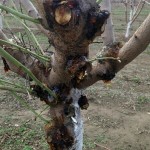
Boron is a micronutrient for almonds. It is required in the process of flower fertilization, being involved in directing the germinating pollen tube. Deficiencies lead to a reduced nut set, and in severe cases, an appearance of a “nonproductive symptom.” Within the tree, boron deficiency can lead to a dieback of small twigs and a “weeping branch” like look. Boron is also toxic at too high of concentrations. Often being found in areas with high soil boron or in blocks irrigated with water containing boron, toxicity symptoms appear as gummy nuts that may form “stick tights” or presence of gum exuding from pruning wounds, bud and leaf scars, and spurs.
Critical threshold levels for boron hull values are as follows:
| Hull Boron Level (PPM) | |
| Deficiency | <80 PPM |
| Sufficient | 100 – 160 PPM |
| Toxicity | >300 PPM |
To determine if an orchard is deficient in or showing toxicity from boron, hull samples must be collected. Since the hulls serve as the primary boron sink, they tend to accumulate the nutrient, and provide a consistent reading. Leaf values are not effective in determining adequate levels. This is because they are not able to detect toxicities and are inconsistent at the lower end of the sufficiency levels. This is demonstrated in table 1, which compares boron mid-July leaf and hull values from several different orchards. In the orchards, leaf values are all very similar, but hull analysis revealed some orchards were deficient.
| Orchard | Block | Sample | Boron Leaf (PPM) | Boron Hull (PPM) |
| 1 | 1 | 1 | 31.8 | 102 |
| 2 | 32.8 | 85.7 | ||
| 2 | 1 | 34.7 | 117 | |
| 2 | 32.3 | 111 | ||
| 2 | 1 | 1 | 29.3 | 175 |
| 2 | 31.7 | 62.1 | ||
| 3 | 1 | 1 | 28.4 | 122 |
| 2 | 29.7 | 84 | ||
| 4 | 1 | 1 | 28.8 | 53 |
| 2 | 27.7 | 82 | ||
| 2 | 1 | 28.7 | 86 | |
| 2 | 29.7 | 74 |
Boron deficiency can be alleviated through applications of boron to the soil. Caution should be used when determining the rate of material applied as high rates of application may cause toxicity. There have been some reports that boron applied in the summer may lead to stick-tights at harvest; suggesting that is may be better to apply boron in the postharvest or earlier in the season. A foliar spray of boron should always be considered between postharvest and pinkbud. More on boron can be found here and here.


Rod Vilas
August 22, 2014My boron levels have been hoovering in the 80’s ppm, so I broadcasted some boron to the strips of my orchards back in June. My rate was 15#’s of actual boron per acre, with 20 gallons of water per acre. These blocks are flood irrigated, on sandy loam soil, irrigated approximately every 16-18 days after my application. I pulled hull samples on 8/18/14. My results came back in the 80’s again, relatively unchanged from last year.
Shouldn’t I be seeing results by now? Can the trees take up that amount of boron before it is leached out of the root zone?
Thanks!
David Doll
August 22, 2014Rod,
I would suspect that the boron will show up in next year’s hulls. There is a good chance that it also showed up in this years too – its just that they would read lower than what they did if boron wasn’t applied. A foliar spray is still recommended even with the application.
Boron does leach – just as any salt. I am sure, based on your irrigation system, that it has moved into the rootzone, and some of it may move past, depending upon the amount of water applied. Smaller, more frequent doses for sandy soil and flood irrigation may be a better strategy.
I have to add that applying that high of a rate of boron (15 lbs of actual boron/acre) is a bit risky. At high rates, boron can be toxic and can increase stick tights within the tree. Smaller applications of boron should be made – around 2-4 lbs of actual boron/acre (10-20 lbs of a 20% boron product).
Hope that helps,
David
Q&A for Boron in Almond Orchards - The Almond Doctor
September 20, 2014[…] posted on the importance of boron. These have highlighted the importance of boron for fruit set, reliance on hull sampling for tree boron status, and foliar […]
2015 Harvest Time Updates - The Almond Doctor
August 1, 2015[…] and stuck nuts from boron toxicity. Gummy kernels that occur may be due to boron deficiency and a hull analysis should be performed. Interestingly enough, stick tights due to boron toxicity has also been reported. This is most […]
Poor Nut Removal: Causes - The Almond Doctor
August 14, 2015[…] nuts to stock to the trees, similar to hull rot above. Gum may be a light brown to clear in color. To determine boron toxicity, a hull analysis must be sampled. Soils and water with boron levels over 0.5 mg/l are at risk, with increasing risk as boron levels […]